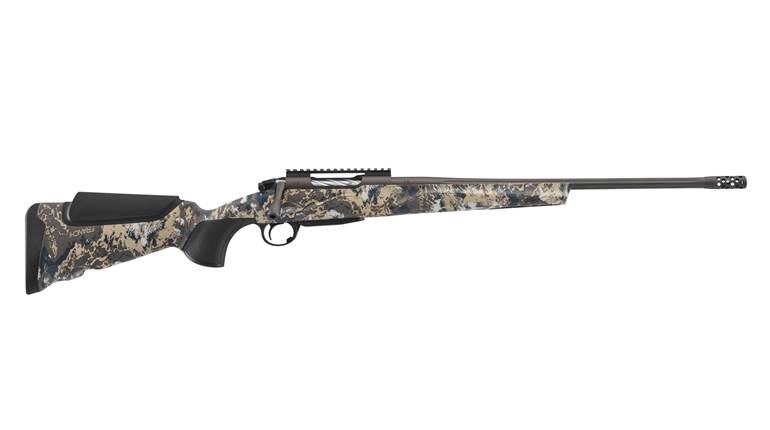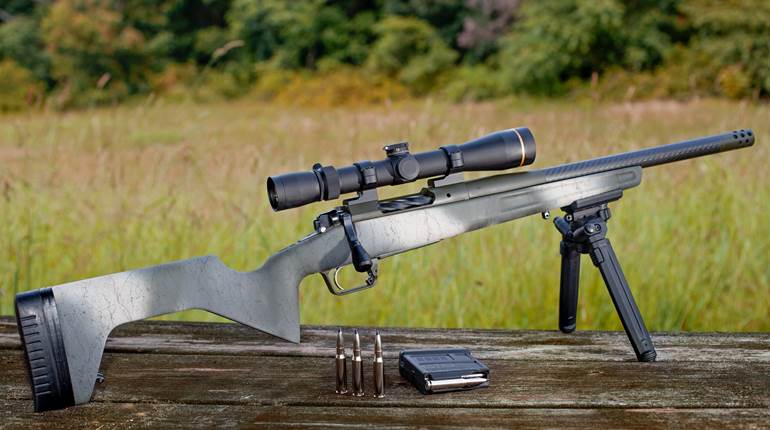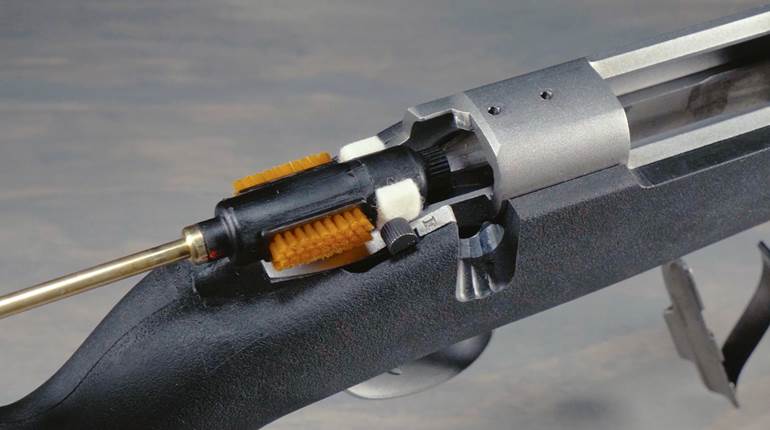
9/17/2012
Chuck Mawhinney was probably born to be a Marine sniper. “My father was a Marine during World War II. I started shooting at a very young age, and he taught me to shoot like the Marines taught him, so there wasn’t any big transition from hunting in Oregon to becoming a sniper.”
Mawhinney graduated from high school in 1967 and immediately joined the Marine Corps—with an agreement that he didn’t have to report until October, after deer season. He graduated from Scout Sniper School at Camp Pendleton in April of 1968 and was sent to Vietnam the next month. He started to “hunt” again almost immediately. More than three decades later, when the totals of modern American snipers were added up, it was discovered that Mawhinney had 103 confirmed kills, more than any other Marine, along with another 216 “probables.”
The Vietnam conflict resulted in many innovations in American sniper rifles. Mawhinney’s primary rifle was the M40, a modified Remington 40X bolt-action in 7.62x51 mm NATO with a Redfield 3-9X Accu-Range scope, developed in 1966 specifically for use as the standard Marine sniper rifle. Updated models of the M40 were used into the 21st century, but Mawhinney’s was the original version with a walnut stock—the only part of the rifle that gave him any trouble. “It was wet most of the time over there, and every couple months we had to take the stock off and do some sanding to keep the barrel free-floated. We hand-painted the stocks camo, but due to the linseed oil finish the paint eventually flaked away.”
“Did you have any problems with anything else?” I asked. “Like bolt handles coming off?”
“Not at all. And I never had any problem with the safety or trigger, either. At the last sniper’s reunion, I was with about 15 other guys and asked them if they’d had any problems. Nobody had. The rifle worked great!”
“How about the scope?”
“Well, the rangefinder was set up to work with the scope on 3X, but when turning my scope up to 9X the zero would change about one minute of angle. So I just left the scope on 9X and sighted-in at 500 yards, estimating the range on shots. Most of our shots came from 300 to 700 yards, due to the terrain. We mostly shot from sitting, and shooting from sitting at somebody 1,000 yards away is senseless.” They kept rain off the scope’s lenses with the typical homemade deer hunter’s solution, a strip cut from a truck tire inner-tube.
For night shooting Mawhinney used the M14 in semi-automatic mode, with the then-new MPS-9 Starlight scope. “They never gave us any training. The scopes just showed up when we were already over there. They told us each scope cost six thousand dollars, and if we broke ’em, we bought ’em.
“There weren’t any instructions, and at first it took forever to get them zeroed at night, the only time you could see through the scope. We just fooled around until we could hit an empty cigarette pack at 50 yards. That was good enough for night-shooting, which was almost all at no more than 100 yards.
“Then somebody looked inside the kit one day and found a smoked lens that fit the front of the scope. We figured out it was for looking through the scope in daylight. After that we just adjusted the scope to line up with the rifle’s iron sights. That made sighting-in a lot easier!”
The best-known of Mawhinney’s engagements took place at night. Intelligence reports indicated an NVA unit of “battalion to regimental size” approaching the area. Mawhinney’s unit was about 125 men, and no support was available from either air or artillery.
By then he knew the area well, and told his commanding officer that he knew a place on the river where the water was at most four feet deep. He was certain the NVA would try to cross there, and suggested that he and his spotter cover the ford that night. At first the officer absolutely refused to consider the idea, but eventually Mawhinney talked him into it.
“It was during the monsoon season, and the river had just dropped after heavy rains. It was still cloudy, but sheet lightning up in the clouds lit everything up like starlight. We sneaked into a place near the ford and sat in an eddy-cut eroded into the bank. Pretty soon an NVA scout started across the river. I didn’t want to let him get into the elephant grass on the other side, and had the scope on his head—about all that showed above the water—but when he got close to the grass he stopped. He stood there for a little bit, looking around, then waded back across the river the way he’d come.
“Pretty soon a bunch more showed up, and when they got out into the water I started shooting, killing 16, all with head shots, until they stopped coming. I shot the rifle 16 times. Evidently that intimidated the rest of the unit, and they all pulled out during the night. The river’s current carried away all but two of the NVA I’d shot. That was on February 14th of 1969, St. Valentine’s Day.”
Mawhinney didn’t much like what he calls the “spit and polish” part of being a Marine. He preferred being in the bush, where he grew a beard and dressed however he liked. “When I’d come in after a few weeks on patrol, I’d have to hack most of my beard and hair off with my Ka-Bar before really getting cleaned up.” He was sent back to the States in September of 1970, where he served as a rifle instructor at Camp Pendleton for a few months.
Mawhinney then went to work for the U.S. Forest Service back in Oregon. He didn’t tell many people about his role in Vietnam, not even his wife, Robin, but in 1991 Joseph Ward’s book, Dear Mom: A Sniper’s Vietnam appeared, crediting Mawhinney with 101 confirmed kills, even more than Carlos Hathcock, who until then had been regarded as the top Marine sniper. After a few years Mawhinney started embracing his new role, appearing frequently in public.
Along the way he also started really appreciating the M40 rifle, his main rifle in Vietnam. Original rifles were scarce, partly because most were fitted with McMillan synthetic stocks during the 1970s. In 2004, the USMC Scout Sniper Association approached Remington about making some commemorative M40s. About 1,500 were made and sold—but they didn’t have scopes, and also differed in small ways from the original.
Eventually Mawhinney teamed up with Andrew Hendrick, who owns Riflecraft, Ltd., in the United Kingdom, a company that sells and modifies shooting equipment, and trains professional shooters. In 2006 Mawhinney and Hendrick approached Michael Haugen of Remington, a Special Forces sniper and, at the time, Remington’s military projects manager, about making another, more exact version of the M40. It took a few years, but eventually the rifles appeared, with the actions stamped CBM8541—Charles Benjamin Mawhinney’s initials and his Military Occupational Specialty (MOS) designation. Only 103 were made, one for each of Mawhinney’s confirmed kills.
Modifications were made to each rifle after it left the Remington factory. George Gardner of G.A. Precision free-floated the barrels and pillar-bedded the actions in Marine-Tex, then had Chuck Mawhinney’s signature and the rifle’s individual number from 001 to 103 engraved on the floorplate.
Each rifle also needed a scope. Since Leupold had purchased Redfield they worked with Kevin Trepa, a former Marine officer and vice-president of Leupold’s military and law enforcement branch, to produce a 3-9X scope. Marty Bordson of Badger Ordnance had an original M40 mount, a Redfield modified specifically for the M40, and provided reproductions for the project.
The rifles are more faithful to the original M40 than the first Remington reproduction, right down to the clip-loading slots in the top of the action. “The clips were useless, of course, because of the scope and mount,” Mawhinney explained, “but the slots were there on the original rifle.”
Almost everything else is also exactly the same, from the alloy buttplate to the heavy 24-inch barrel with a 1:12-inch right-hand twist. In fact, the entire rifle weighs 9 3/4 pounds, precisely the same as Mawhinney’s. There’s even a green webbing sling, very close to the sling issued with the original rifle.
One last little problem was ammunition. The load used in Vietnam was 173-grain Lake City match, and a very close approximation was supplied by Black Hills Ammunition, the South Dakota company that makes exceptional ammunition for everything from Cowboy Action Shooting to law enforcement. Jeff Hoffman, owner of Black Hills, supplied its 175-grain boattail hollow-point match load, which Chuck Mawhinney uses to personally break-in and sight-in every rifle.
“First I scrub each bore with JB Compound to do a little polishing, then shoot eight rounds, cleaning the bore between each with Bore-Tech Eliminator. By the time I’m done, every barrel is really smooth. All the rifles group half an inch or less at 100 yards, and some will do a quarter-inch.” He keeps a log book of the date and number of rounds fired through each rifle.
The rifle I tested was number 029. It was fired at the 100-yard range with the Black Hills ammunition. The single five-shot group fired at paper to confirm the sight-in measured 0.48 inches from center to center, with the three shots in the middle of the group making a single, much smaller hole. Aiding this performance, the smooth trigger pull averaged just a hair more than 3 pounds.
Chuck Mawhinney still loves to shoot. His original M40 was eventually rediscovered at the Weapons Training Battalion at Marine Base Quantico, and in 1996 was retrofitted to the same configuration as when he used it in Vietnam. It is now on display at the National Museum of the Marine Corps in Triangle, Va., and except for wear and the lack of the autograph on the floorplate looks just like the new Mawhinney rifle.
The new rifle’s price is $5,000. It ships in a black Plano case, already sighted-in with the Black Hills ammunition, and includes the shooting log book.






































